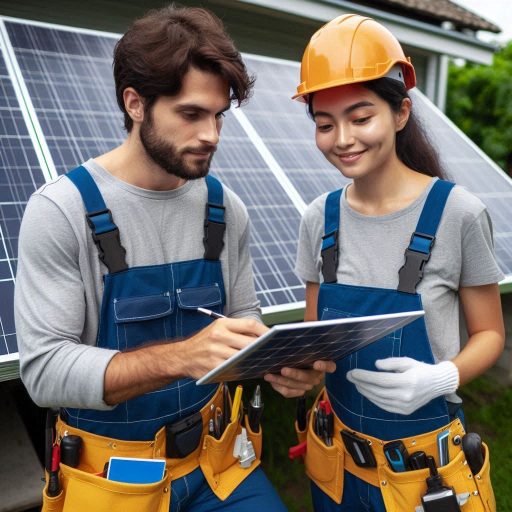Introduction
A brief overview of solar photovoltaic installation shows how solar panels convert sunlight into electricity.
Engineers play a crucial role in designing, installing, and maintaining solar PV systems.
Key Responsibilities of Engineers
Engineers are responsible for site assessment, system design, and ensuring the efficient operation of solar PV systems.
They must evaluate the location, shading, orientation, and roof structure to maximize the system’s energy production.
Engineers use specialized software to create detailed system designs that meet the energy needs of the property.
Installation Process
Engineers oversee the installation process, ensuring that all components are securely mounted and connected according to specifications.
They work closely with electricians to wire the system correctly and safely integrate it into the existing electrical infrastructure.
Engineers conduct thorough inspections to verify that the system is functioning optimally and meeting performance expectations.
Maintenance and Troubleshooting
Engineers perform regular maintenance to keep solar PV systems operating efficiently and extend their lifespan.
They troubleshoot any issues that arise, such as equipment malfunctions or performance dips, to ensure continuous system operation.
Engineers stay informed about technological advancements to recommend upgrades that enhance system performance and reliability.
In essence, engineers play a vital role in every stage of solar photovoltaic installation, from design to maintenance.
Their expertise and attention to detail are essential for the successful implementation of solar energy systems.
Understanding the technology
Solar Panels and How They Work
Solar photovoltaic (PV) technology converts sunlight into electricity using solar panels.
These panels contain photovoltaic cells made from semiconductor materials.
When sunlight strikes these cells, they generate direct current (DC) electricity.
An inverter then converts the DC electricity into alternating current (AC), which powers homes and businesses.
Different Types of Solar Photovoltaic Systems
There are different types of solar photovoltaic systems.
The most common are grid-tied, off-grid, and hybrid systems.
Grid-tied systems connect to the local utility grid, allowing excess electricity to be sent back to the grid.
This system is popular because it reduces reliance on traditional power sources.
Off-grid systems operate independently from the grid, often using batteries to store electricity for use during cloudy days or at night.
These systems are ideal for remote areas with no access to the power grid.
Hybrid systems combine the benefits of both grid-tied and off-grid systems, offering greater flexibility and reliability.
Understanding these different types of solar photovoltaic systems is crucial for engineers working in this field.
Each system has unique design requirements and operational considerations.
For example, designing a grid-tied system involves ensuring proper synchronization with the utility grid.
In contrast, off-grid systems require careful planning of battery storage capacity to ensure continuous power supply.
Engineers must also consider factors like solar panel placement, angle, and orientation to maximize energy production.
Importance of Having Engineering Knowledge in This Field
Engineering knowledge plays a vital role in solar photovoltaic installations.
Engineers are responsible for designing efficient and reliable solar energy systems.
They must understand the electrical, structural, and environmental aspects of solar installations.
Electrical engineers, for instance, design the wiring and connection systems to ensure safe and efficient energy transfer.
Structural engineers assess the load-bearing capacity of roofs or other mounting structures to ensure they can support the weight of solar panels.
Environmental engineers also play a crucial role in solar photovoltaic installations.
They evaluate the environmental impact of the installation and ensure compliance with local regulations.
This includes assessing the potential for soil erosion, water runoff, and other environmental factors that could affect the installation.
Engineers also contribute to the development of new solar technologies.
They work on improving the efficiency of photovoltaic cells, designing better inverters, and developing advanced battery storage solutions.
Having engineering knowledge in the solar photovoltaic field is essential for several reasons.
First, it ensures that solar installations are safe and comply with industry standards.
Engineers must follow strict guidelines to prevent electrical hazards and structural failures.
Second, engineering expertise helps optimize the performance of solar systems.
Engineers use their knowledge to design systems that maximize energy production and minimize costs.
Finally, engineers play a key role in advancing solar technology, driving innovation and making solar energy more accessible and affordable.
Understanding the technology behind solar photovoltaic systems is essential for engineers in this field.
Their expertise ensures safe, efficient, and innovative solar energy solutions.
Site assessment and planning
Engineers Play a Crucial Role in Evaluating the Site for Solar Installation
Engineers are essential in the successful installation of solar photovoltaic (PV) systems, starting with a thorough site assessment.
They evaluate the geographical location, analyzing factors such as sunlight exposure, shading, and weather conditions.
This evaluation ensures the site receives maximum sunlight throughout the year, which is crucial for optimizing energy production.
Engineers identify potential obstacles, like trees or buildings, that may affect efficiency by casting shadows.
Their assessment also includes considering the orientation and tilt of the solar panels to maximize sunlight capture.
Determining the Optimal Placement of Solar Panels
Once the site assessment is complete, engineers focus on planning the installation.
They determine the optimal placement of the solar panels by considering various factors such as the size of the property, the energy consumption patterns, and the local climate.
Engineers analyze the site to decide the best configuration for the solar panels, ensuring they are positioned to capture the most sunlight.
This involves selecting the appropriate type and number of solar panels and determining the best layout for installation.
Calculating the Energy Needs of the Location
In addition to determining panel placement, engineers calculate the energy needs of the location.
They take into account factors like property size, energy consumption patterns, and the local climate.
Engineers use this information to design a system that meets the site’s energy demands while maximizing efficiency.
This includes planning the electrical layout, considering the placement of inverters, wiring, and other components.
To ensure the efficient flow of electricity from the panels to the building or grid.
Throughout the planning process, engineers collaborate with other professionals, such as architects and construction teams, to ensure a seamless and efficient installation.
They also consider local regulations and building codes to ensure compliance and avoid legal issues.
By carefully assessing the site and planning the installation, engineers play a vital role in ensuring the success of solar photovoltaic projects.
Generally, engineers are essential in the site assessment and planning stages of solar photovoltaic installation.
Their expertise in evaluating the site, determining the optimal placement of solar panels.
And calculating the energy needs of the location ensures that the installation is both efficient and effective.
Without their careful planning and attention to detail, solar projects would not achieve their full potential in terms of energy production and sustainability.
Transform Your Career Today
Unlock a personalized career strategy that drives real results. Get tailored advice and a roadmap designed just for you.
Start NowDesign and Engineering
Engineers Create Detailed Plans for the Installation
Engineers play a crucial role in solar photovoltaic (PV) installations by creating detailed plans that guide the entire process.
These plans cover every aspect of the installation, from precise measurements to layout designs and equipment specifications.
By meticulously planning, engineers ensure that the installation is both efficient and effective.
They take into account the specific characteristics of the site, such as roof orientation and sunlight exposure, to optimize the system’s performance.
Ensuring the System Meets All Building Codes and Regulations
A key responsibility of engineers in solar PV installations is ensuring that the system meets all relevant building codes and regulations.
Engineers thoroughly review local, state, and national codes, focusing on factors like structural integrity, electrical safety, and fire prevention.
By adhering to these standards, engineers prevent potential hazards and guarantee the system’s safety for both installers and end-users.
Their expertise ensures that the installation complies with legal requirements, avoiding any issues that could arise from non-compliance.
Designing a System that Maximizes Energy Production and Efficiency
Engineers are also responsible for designing solar PV systems that maximize energy production and efficiency.
They analyze the installation site, considering factors like sunlight exposure, shading, and roof orientation.
This analysis helps them determine the optimal placement of solar panels to capture the most sunlight throughout the day.
Engineers also select the right components, such as inverters and mounting structures.
To ensure that the system operates at peak efficiency while remaining cost-effective.
Additionally, they consider the integration of the solar PV system with the building’s existing electrical infrastructure.
Ensuring a seamless connection to the grid or independent operation if required.
In short, engineers are vital to the successful installation of solar PV systems.
They create detailed plans, ensure compliance with all regulations, and design systems that maximize energy efficiency.
Their expertise ensures that solar installations are not only effective but also safe, sustainable, and adaptable to future needs.
Through careful design and engineering, they help pave the way for a cleaner, more sustainable energy future.
Read: Future of CAD Technician Jobs in Engineering
Equipment selection and procurement
Engineers Help in Selecting the Right Solar Panels, Inverters, and Mounting Systems
Engineers play a crucial role in selecting the right solar panels, inverters, and mounting systems for photovoltaic installations.
They evaluate different types of solar panels based on efficiency, durability, and cost.
Engineers ensure that the chosen panels capture maximum sunlight and convert it effectively into energy.
For inverters, they assess capacity and efficiency to match the energy needs of the system, ensuring compatibility with solar panels and other components.
They also focus on selecting appropriate mounting systems that secure the panels to rooftops or ground mounts.
Considering site-specific requirements like roof type or ground conditions.
Ensuring the Equipment Meets Quality Standards and Specifications
Quality standards are a primary concern during equipment selection.
Engineers verify that all components meet industry standards and manufacturer specifications.
They review certifications and test reports to ensure that the equipment is reliable and performs as expected.
By adhering to quality standards, engineers reduce the risk of equipment failure and ensure the system operates efficiently over its lifespan.
This rigorous approach helps maintain the integrity and performance of the solar PV installation.
Managing the Procurement Process to Ensure Timely Delivery
Engineers are also integral to managing the procurement process for solar PV projects.
They handle the sourcing of equipment and ensure its timely delivery to the installation site.
This involves coordinating with suppliers, tracking orders, and addressing any issues that arise.
Engineers negotiate contracts to secure the best terms for the project and oversee the inspection of delivered equipment to confirm it meets required standards before installation begins.
Effective procurement management by engineers helps maintain the project‘s schedule and budget, contributing to the successful deployment of solar technologies.
In summary, engineers are essential in the equipment selection and procurement stages of solar PV installations.
They ensure the right panels, inverters, and mounting systems are chosen, meet quality standards, and are procured on time.
Their expertise and management skills help ensure that solar projects are successful and contribute to the advancement of renewable energy.
Read: Quality Control Inspector: Entry-Level Guide

Installation and Commissioning
Engineers Supervise the Actual Installation Process
Engineers are integral to the successful installation of solar photovoltaic systems.
Their role begins with meticulous planning and extends through every stage of the installation process.
Engineers supervise the actual installation, ensuring that all components are installed according to the design specifications and safety standards.
Their oversight is critical to the project’s success, as it ensures that the system operates efficiently and safely for years to come.
During the installation, engineers work closely with technicians and contractors, guiding them through the process.
They ensure that the installation site is prepared correctly, with all necessary infrastructure in place.
Engineers also verify that the equipment, such as mounting structures and solar panels, meets the required quality standards before installation begins.
Their attention to detail helps prevent costly errors and ensures that the installation proceeds smoothly.
Engineers also manage the timeline and logistics of the installation process.
They coordinate the delivery of materials, schedule work, and ensure that the project stays on track.
Their ability to manage these complex tasks ensures that the installation is completed on time and within budget.
Throughout the process, engineers remain vigilant, identifying and addressing any issues that arise.
Ensuring that the project meets all performance and safety expectations.
Ensuring Proper Mounting and Wiring of Solar Panels
One of the most critical aspects of the installation process is ensuring the proper mounting and wiring of the solar panels.
Engineers take the lead in this phase, verifying that the solar panels are securely attached to the mounting structures.
Proper mounting is essential to protect the panels from environmental factors like wind, rain.
And temperature fluctuations, which could damage the system if not correctly installed.
Engineers carefully calculate the optimal angle and orientation for the panels, taking into account the geographical location and the specific site conditions.
This precision ensures that the panels receive maximum sunlight throughout the day, thereby optimizing energy production.
Incorrectly mounted panels can result in reduced efficiency and, in some cases, system failure, making the engineer’s role in this step crucial.
Wiring is another critical component of the installation that falls under the engineer’s purview.
Engineers oversee the entire wiring process, ensuring that all electrical connections are made according to the design specifications.
Proper wiring is essential for the safe and efficient operation of the system.
Engineers ensure that the connections between the solar panels, inverters, and other components are secure and correctly configured.
They also verify that the system’s grounding is adequate to prevent electrical hazards.
Engineers also ensure that the inverters are installed and connected properly.
Inverters play a vital role in converting the direct current (DC) generated by the solar panels into alternating current (AC), which can be used by homes and businesses.
Engineers ensure that the inverters are compatible with the system and are functioning correctly.
Proper installation of the inverters is essential to avoid power losses and ensure that the system operates at peak efficiency.
Testing the System and Commissioning It for Operation
Once the installation is complete, engineers move on to the critical phase of testing and commissioning the solar photovoltaic system.
Testing is an essential step that ensures the system functions as intended and meets all safety and performance standards.
Engineers conduct a series of tests to verify that the system is operating correctly and efficiently.
During the testing phase, engineers check the voltage output of the system, ensuring that it meets the design specifications.
They also verify that all electrical connections are secure and that there are no issues with the wiring or components.
Engineers perform these tests under various conditions to ensure that the system can handle different environmental factors, such as changes in sunlight, temperature, and load.
Engineers’ Critical Role in Testing, Commissioning, and Ensuring Solar PV Success
If any issues are identified during testing, engineers promptly address them.
They may make adjustments to the system, replace faulty components, or reconfigure the wiring to optimize performance.
Engineers’ expertise and attention to detail during this phase are crucial to ensuring the system’s long-term reliability and efficiency.
After successful testing, engineers proceed with the commissioning of the solar photovoltaic system.
Commissioning is the process of officially activating the system and connecting it to the electrical grid.
Engineers ensure that the system meets all regulatory requirements and complies with local codes and standards during this process.
They work closely with utility companies and regulatory bodies to ensure a smooth and compliant commissioning process.
In addition to activating the system, engineers also provide documentation and training to the system’s owners or operators.
They ensure that the people responsible for the system’s day-to-day operation understand how to use and maintain it properly.
Proper training helps prevent potential issues and ensures that the system operates at peak efficiency throughout its lifespan.
Most importantly, engineers play an indispensable role in the installation and commissioning of solar photovoltaic systems.
Their supervision, attention to detail, and expertise ensure that the system is installed correctly, functions efficiently, and meets all safety and regulatory standards.
Through their efforts, engineers contribute significantly to the successful implementation of solar energy projects.
Helping to drive the adoption of renewable energy sources worldwide.
Read: CAD Technician vs. Draftsman: Key Differences
Maintenance and monitoring
Engineers Play a Role in Developing Maintenance Schedules
Engineers play a crucial role in developing effective maintenance schedules for solar photovoltaic (PV) installations.
They assess the system’s specific needs and create detailed plans to ensure consistent performance.
By understanding each installation’s unique requirements, engineers tailor maintenance schedules that prevent potential issues and extend the system’s lifespan.
These schedules are designed to address both routine maintenance tasks and more complex inspections.
Ensuring that every component of the PV system functions optimally.
Monitoring the System’s Performance and Addressing Any Issues
Monitoring the system’s performance is another vital responsibility for engineers.
They use advanced software and tools to track energy production, system efficiency, and overall functionality.
Continuous monitoring allows engineers to identify any deviations from expected performance quickly.
When issues arise, engineers address them promptly, minimizing downtime and maximizing energy output.
By staying vigilant and responsive, engineers ensure that the solar PV system consistently operates at its highest potential.
Contributing to long-term sustainability and energy savings.
Conducting Regular Inspections to Ensure Optimal Operation
Conducting regular inspections is essential for maintaining the optimal operation of solar PV systems.
Engineers examine panels, inverters, wiring, and other components to detect wear, damage, or inefficiencies.
These thorough inspections help prevent small problems from escalating into costly repairs.
Engineers also ensure that the system remains compliant with safety standards and regulations during these inspections.
By conducting regular checks and addressing any issues found, engineers play a key role in ensuring that the solar PV system remains efficient, safe, and reliable throughout its lifespan.
Overall, engineers’ involvement in maintenance and monitoring is indispensable to the success of solar photovoltaic installations.
Their expertise ensures that these systems deliver clean, renewable energy effectively for years to come.
By developing maintenance schedules, monitoring performance, and conducting regular inspections, engineers help maximize the return on investment for solar PV systems.
Read: Best Online Courses for CAD Technician Training
You Might Also Like: How Transportation Engineers Improve Public Transit
Compliance and regulations
Engineers Ensure That the Installation Meets All Local and National Regulations
Engineers play a crucial role in ensuring solar photovoltaic installations comply with all local and national regulations.
They meticulously review guidelines and codes governing solar system installations.
This thorough understanding helps them design systems that meet regulatory requirements from the outset, minimizing the risk of project delays or legal issues.
Obtaining Necessary Permits and Approvals for the Project
One of the primary responsibilities of engineers in solar photovoltaic installation is obtaining the necessary permits and approvals.
Engineers collaborate with local authorities to ensure all paperwork is in order before the project begins.
This process involves submitting detailed plans, conducting site assessments, and demonstrating that the proposed system will adhere to all applicable regulations.
By securing these permits, engineers help pave the way for a smooth installation process, avoiding potential setbacks from non-compliance.
Transform Your Career Today
Unlock a personalized career strategy that drives real results. Get tailored advice and a roadmap designed just for you.
Start NowEnsuring the System is Compliant with Safety Standards
Beyond obtaining permits, engineers ensure that the solar photovoltaic system is fully compliant with safety standards.
They rigorously assess the installation site, identifying potential hazards and designing the system to mitigate risks.
This includes ensuring that the system is properly grounded, that electrical connections are secure, and that the components used are of high quality and meet industry standards.
Engineers also oversee the installation process, working closely with contractors to verify that the system is installed correctly and safely.
Compliance with safety standards is not just about following regulations; it‘s about protecting the people who will work on or live near the installation.
Engineers take this responsibility seriously, implementing safeguards that protect against electrical faults, fire hazards, and other risks associated with solar energy systems.
They also ensure that the system is designed to withstand environmental factors such as wind, rain, and temperature fluctuations, further enhancing its safety and reliability.
In addition to local and national regulations, engineers must also consider international standards, especially for projects that involve exporting solar energy or components.
They ensure that the system design and installation comply with international codes and best practices.
Ensuring Regulatory Compliance and Legal Assurance in Solar PV Projects
Facilitating smoother cross-border operations and reducing the risk of legal complications.
Throughout the project, engineers maintain meticulous records of their compliance efforts.
These records serve as evidence that the installation meets all necessary regulations and can be crucial in the event of an audit or inspection.
By keeping detailed documentation, engineers provide assurance to stakeholders, including investors and regulatory bodies.
That the project is being managed responsibly and in accordance with the law.
In summary, engineers are essential in ensuring that solar photovoltaic installations meet all compliance and regulatory requirements.
From securing permits to adhering to safety standards, their expertise ensures that the system is safe, reliable, and legally compliant.
Contributing to the successful deployment of solar energy projects.
Learn More: Daily Responsibilities of a Solar PV Installer Engineer
Conclusion
Engineers play a vital role in solar photovoltaic (PV) installation, contributing to the success of each project.
They ensure that the design, planning, and execution of solar installations meet the required standards.
Engineers assess site conditions to determine the optimal placement of solar panels, maximizing energy production.
Their technical expertise helps in selecting the right materials and equipment, which enhances the efficiency and longevity of the system.
Engineers are responsible for designing the electrical systems that connect the solar panels to the grid or storage systems.
This includes selecting appropriate wiring, inverters, and safety mechanisms to ensure that the system operates effectively and safely.
Their knowledge of electrical codes and standards is crucial in preventing potential hazards and ensuring compliance with regulations.
Moreover, engineers play a key role in troubleshooting and resolving issues that may arise during installation.
They provide solutions that minimize downtime and prevent costly delays.
Their problem-solving skills ensure that the project stays on track, both in terms of budget and timeline.
In addition to their technical expertise, engineers collaborate with other professionals involved in the project, such as architects, contractors, and project managers.
This collaboration ensures that all aspects of the installation are coordinated and executed seamlessly.
Engineers also communicate with clients to explain technical details and provide guidance on system maintenance and operation.
[E-Books for Sale]
The Big Book of 500 High-Paying Jobs in America: Unlock Your Earning Potential
$19.99 • 500 High-Paying Jobs • 330 pages
Explore 500 high-paying jobs in America and learn how to boost your career, earn more, and achieve success!
See All 500 High-Paying Jobs of this E-Book
1001 Professions Without a Degree: High-Paying American Jobs You Can Start Now
$19.99 • 1001 Professions Without a Degree • 174 pages
Discover 1001 high-paying jobs without a degree! Unlock career tips, skills, and success strategies for just $19.99!




